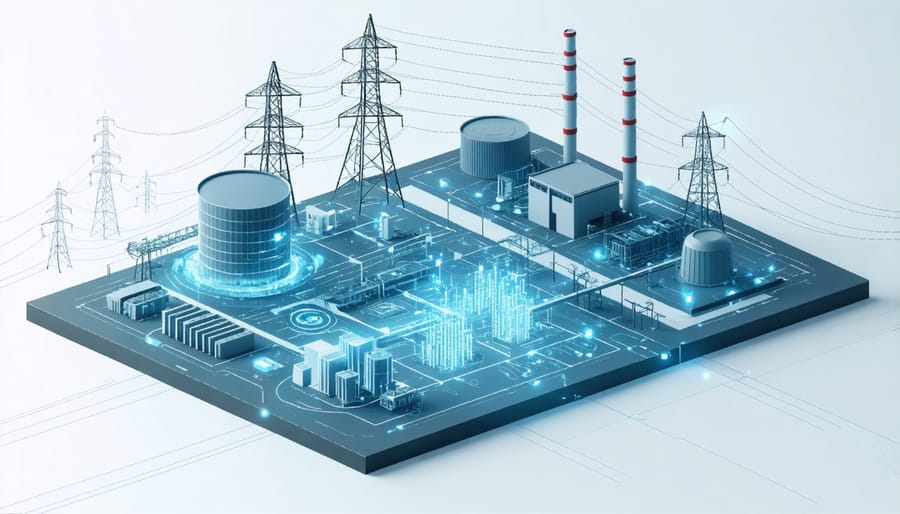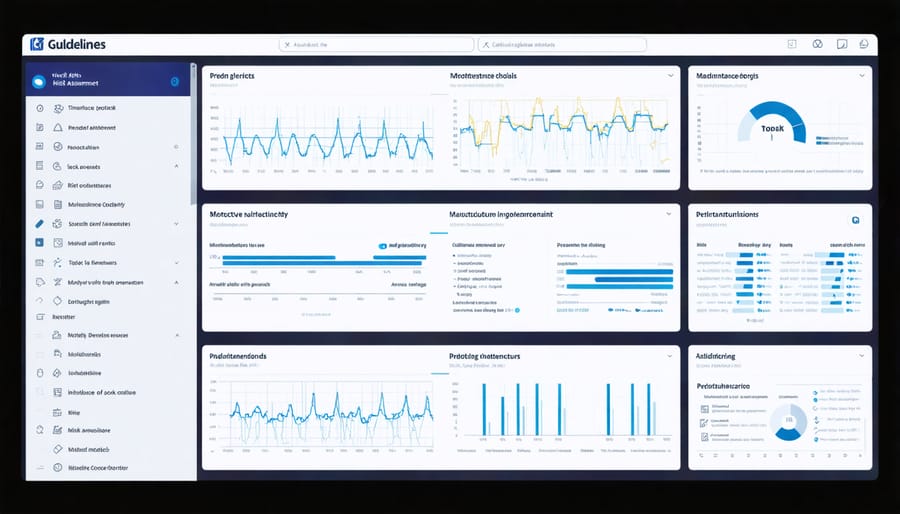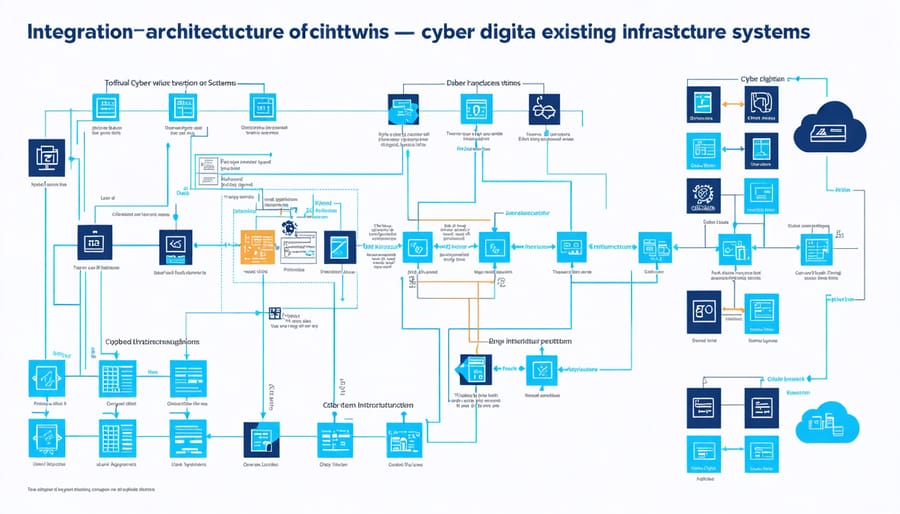In an era where cybersecurity threats pose unprecedented risks to critical infrastructure, cyber digital twins emerge as a revolutionary approach to safeguarding industrial systems. These sophisticated virtual replicas simulate real-world operations in real-time, enabling organizations to predict, detect, and neutralize cyber threats before they impact physical assets. By creating an exact digital counterpart of operational technology (OT) environments, cyber digital twins provide infrastructure managers with a powerful platform for testing security protocols, conducting vulnerability assessments, and orchestrating incident response strategies without risking live systems.
The integration of cyber digital twins represents a paradigm shift in how construction and infrastructure professionals approach cybersecurity risk management. Unlike traditional security measures that react to threats, these advanced simulations enable proactive defense strategies through continuous monitoring, predictive analytics, and scenario-based testing. For construction industry leaders and facility managers responsible for protecting mission-critical assets, cyber digital twins offer an unprecedented opportunity to strengthen security posture while optimizing operational performance.
This transformative technology arrives at a crucial moment when infrastructure digitalization accelerates across sectors, making robust cybersecurity frameworks more essential than ever. As we explore the capabilities and implementation considerations of cyber digital twins, we’ll examine how this innovative solution is reshaping the future of infrastructure security and operational resilience.
Understanding Cyber Digital Twins in Infrastructure
Core Components of Cyber Digital Twin Technology
A cyber digital twin system comprises several essential technological components that work in harmony to create an accurate virtual representation of physical assets and systems. At its foundation lies the data acquisition layer, which includes IoT sensors, monitoring devices, and automated data collection systems that continuously gather real-time information from the physical environment.
The integration platform serves as the system’s backbone, processing and synchronizing data from multiple sources while ensuring seamless communication between different components. Advanced analytics engines powered by machine learning algorithms analyze this data stream, identifying patterns, predicting potential issues, and generating actionable insights.
Visualization technologies, including 3D modeling and augmented reality interfaces, create interactive representations that enable stakeholders to monitor and interact with the digital twin effectively. The simulation engine performs complex calculations and scenario testing, allowing users to evaluate different operational scenarios without risking physical assets.
Security frameworks protect both the physical and digital components, while APIs and middleware facilitate integration with existing systems and databases. These components are supported by robust cloud infrastructure, ensuring scalability, reliability, and accessibility across different locations and devices.

Real-time Data Integration and Monitoring
Real-time data integration is the cornerstone of cyber digital twin functionality, enabling continuous monitoring and analysis of infrastructure systems. Through strategically placed IoT sensors, these digital replicas collect vast amounts of operational data, including structural performance metrics, environmental conditions, and usage patterns. Advanced integration systems process this data stream using sophisticated algorithms that transform raw information into actionable insights.
The monitoring framework typically operates on three levels: data acquisition, processing, and analysis. At the acquisition level, sensors capture physical parameters such as temperature, strain, vibration, and displacement. This data flows through secure networks to central processing units where it undergoes initial filtering and validation. The analysis layer then employs machine learning algorithms to identify patterns, predict potential issues, and generate automated alerts.
Modern cyber digital twins can process millions of data points per second, creating a comprehensive view of infrastructure health and performance. This capability enables predictive maintenance strategies, real-time risk assessment, and informed decision-making. Integration with building management systems (BMS) and enterprise resource planning (ERP) platforms ensures that stakeholders across the organization have access to relevant information through customized dashboards and reporting interfaces.
Risk Management Applications

Predictive Maintenance and Failure Prevention
Cyber digital twins revolutionize maintenance strategies by enabling organizations to predict and prevent infrastructure failures before they occur. By creating virtual replicas of physical assets, these systems continuously monitor performance metrics, structural integrity, and operational parameters in real-time.
Through advanced analytics and AI-powered threat detection systems, cyber digital twins can identify patterns and anomalies that might indicate potential failures. This predictive capability allows maintenance teams to shift from reactive to proactive maintenance approaches, significantly reducing downtime and maintenance costs.
For example, in building management systems, digital twins can monitor HVAC performance, structural stress points, and electrical systems simultaneously. When performance metrics deviate from established baselines, the system alerts facility managers to potential issues, enabling them to address problems before they escalate into critical failures.
The technology also enables scenario testing and simulation of different maintenance strategies, helping organizations optimize their maintenance schedules and resource allocation. By analyzing historical data and performance trends, digital twins can accurately predict component lifespans and recommend optimal replacement timing, ensuring maximum asset efficiency while minimizing unnecessary maintenance interventions.
This predictive maintenance capability has demonstrated significant returns on investment, with some organizations reporting up to 30% reduction in maintenance costs and 70% decrease in unexpected equipment failures.
Cybersecurity Enhancement
Cyber digital twins play a crucial role in enhancing cybersecurity by creating a safe environment for testing and identifying potential vulnerabilities without risking actual infrastructure systems. Through continuous monitoring and real-time analysis, these digital replicas enable organizations to detect threats before they impact physical assets. By integrating with existing infrastructure security protocols, digital twins provide a comprehensive view of system vulnerabilities and potential attack vectors.
The technology enables security teams to simulate various cyber-attack scenarios, evaluate system responses, and develop effective countermeasures. This proactive approach to security management allows organizations to identify weaknesses in their digital infrastructure and implement necessary improvements before actual breaches occur. The twin environment also facilitates the testing of security patches and updates without disrupting ongoing operations, ensuring system integrity while maintaining operational continuity.
Furthermore, cyber digital twins provide valuable insights through predictive analytics, helping organizations anticipate and prepare for emerging security threats. This capability is particularly valuable in critical infrastructure projects where security breaches could have severe consequences.
Emergency Response Planning
Cyber digital twins excel in emergency response planning by enabling organizations to simulate and test various crisis scenarios without risking actual infrastructure. Through advanced predictive threat analysis, teams can develop and refine response protocols for cyber attacks, system failures, and natural disasters.
These virtual environments allow security teams to conduct realistic drills, measuring response times and identifying potential vulnerabilities in emergency procedures. By creating detailed simulations of critical infrastructure systems, organizations can evaluate the cascade effects of different threats and optimize their incident response strategies.
The technology enables stakeholders to test multiple response scenarios simultaneously, comparing outcomes and determining the most effective course of action. This capability proves particularly valuable in complex infrastructure systems where traditional tabletop exercises may fall short. Emergency response teams can practice their protocols in a risk-free environment, ensuring they’re well-prepared for real-world incidents while maintaining operational continuity.
Implementation Challenges and Solutions
Technical Infrastructure Requirements
Implementing a cyber digital twin requires a robust technical infrastructure that combines various hardware and software components. At its core, the system needs high-performance computing capabilities to handle complex simulations and real-time data processing. This typically includes dedicated servers with sufficient processing power and storage capacity to manage large volumes of operational data.
The infrastructure must incorporate advanced networking capabilities, including high-speed internet connectivity and secure communication protocols. IoT sensors and data collection devices form a crucial component, providing continuous real-time data feeds from physical assets to their digital counterparts.
Data management systems are essential, including specialized databases capable of handling both structured and unstructured data. These systems must support rapid data retrieval and analysis while maintaining data integrity and security. Visualization tools and interfaces are required to render 3D models and present analytical insights effectively.
Security infrastructure is paramount, requiring multiple layers of protection including firewalls, encryption systems, and access control mechanisms. The system should also include backup and disaster recovery capabilities to ensure business continuity.
Integration capabilities are necessary to connect with existing enterprise systems such as Building Management Systems (BMS), Enterprise Resource Planning (ERP) software, and other operational technology platforms. Cloud computing resources may be utilized to provide scalability and accessibility, though some organizations may opt for on-premises solutions based on security requirements.
Integration with Existing Systems
Integrating cyber digital twins with existing infrastructure requires a strategic approach that prioritizes compatibility and minimal disruption to ongoing operations. Organizations typically begin by conducting a comprehensive systems audit to identify integration points and potential challenges. This process involves mapping current technological infrastructure, including legacy systems, operational technologies (OT), and IT networks.
A layered integration approach has proven most effective, starting with data collection interfaces that connect physical assets to the digital twin environment. This often involves implementing IoT sensors, smart meters, and monitoring devices that can communicate with both existing systems and the new digital twin platform. API-driven integration frameworks facilitate seamless data exchange between legacy systems and the digital twin environment.
Security considerations are paramount during integration, necessitating the implementation of secure communication protocols and encryption methods. Organizations should establish dedicated integration environments for testing before deploying to production systems. This allows for thorough validation of data flows and system interactions without risking operational disruption.
Successful integration also requires careful consideration of data standardization and governance policies. Organizations must ensure that data formats are compatible across systems and that proper data handling procedures are in place. Many organizations opt for a phased integration approach, starting with critical systems and gradually expanding the digital twin’s scope as confidence and capabilities grow.

Future Prospects and Industry Impact
Emerging Technologies and Capabilities
The evolution of cyber digital twin technology is rapidly advancing, driven by innovations in artificial intelligence, machine learning, and real-time data processing capabilities. As construction professionals face emerging cybersecurity challenges, these technological developments are reshaping how we approach infrastructure security and risk management.
Advanced sensor integration and IoT connectivity are enabling more sophisticated digital twin implementations, with enhanced ability to detect and respond to potential threats in real-time. Edge computing capabilities are improving response times and reducing latency, allowing for more immediate action when security incidents occur.
Predictive analytics capabilities are becoming more refined, enabling digital twins to anticipate potential security breaches and system vulnerabilities before they materialize. This proactive approach is particularly valuable for critical infrastructure protection and complex construction projects where downtime can have significant financial implications.
Machine learning algorithms are also becoming more sophisticated in their ability to identify patterns and anomalies, leading to more accurate threat detection and reduced false positives. These improvements are complemented by advances in visualization technologies, making it easier for project teams to interpret and act on security-related data.
The integration of blockchain technology is emerging as a promising development, offering enhanced security and transparency in digital twin implementations while ensuring the integrity of collected data and system modifications.
Industry Adoption Trends
The adoption of cyber digital twins in the construction and infrastructure sectors has shown remarkable growth over the past five years, with a significant acceleration following the global shift toward digital transformation. Industry analysts report that approximately 65% of enterprise-level construction firms have either implemented or are actively planning to deploy cyber digital twin technology within their operations by 2025.
Leading construction companies are primarily utilizing cyber digital twins for large-scale infrastructure projects, particularly in smart city developments and critical facility management. The technology has gained substantial traction in regions with advanced digital infrastructure, with North America and Western Europe showing the highest adoption rates, followed by rapid uptake in Asia-Pacific markets.
Market research indicates that mid-sized construction firms are increasingly exploring scaled-down versions of cyber digital twin solutions, focusing on specific use cases such as security assessment and risk management. This trend is expected to continue as the technology becomes more accessible and cost-effective.
According to industry surveys, the primary drivers for adoption include enhanced risk management capabilities (cited by 78% of respondents), improved operational efficiency (65%), and better decision-making through predictive analytics (58%). However, implementation challenges such as initial investment costs and technical expertise requirements continue to influence adoption patterns, particularly among smaller organizations.
Experts predict that by 2027, cyber digital twins will become standard practice for critical infrastructure projects, driven by increasing regulatory requirements and the growing need for sophisticated cybersecurity measures in smart building systems.
As we’ve explored throughout this analysis, cyber digital twins represent a transformative technology for the construction industry, offering unprecedented capabilities in risk management, operational efficiency, and security optimization. The integration of these virtual replicas with physical infrastructure systems has demonstrated significant potential for improving decision-making processes and reducing vulnerabilities across construction projects.
Key takeaways for implementation include the importance of establishing clear objectives before deployment, ensuring robust data security measures, and maintaining regular updates to keep the digital twin synchronized with its physical counterpart. Success in implementing cyber digital twins requires a coordinated approach involving stakeholders from IT, operations, and management teams.
To maximize the benefits of cyber digital twin technology, organizations should:
– Begin with a pilot project to demonstrate value and gain experience
– Invest in comprehensive staff training programs
– Establish clear metrics for measuring ROI
– Develop standardized procedures for data collection and analysis
– Regular review and update security protocols
Looking ahead, the evolution of cyber digital twins will likely continue to accelerate, driven by advances in IoT technology, artificial intelligence, and cloud computing. Construction professionals who embrace this technology early will be better positioned to address future challenges and maintain competitive advantage in an increasingly digital industry.
For optimal results, organizations should approach implementation as a strategic initiative rather than a purely technical project, ensuring alignment with broader business objectives and long-term digital transformation goals.

